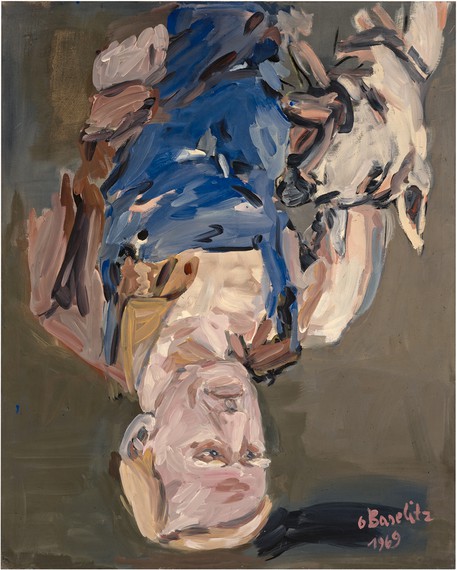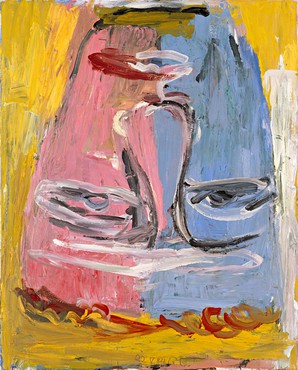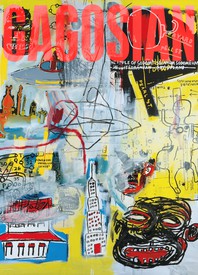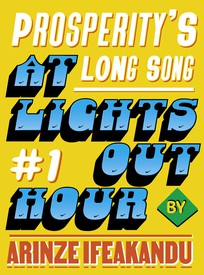Donation
Georg Baselitz
Metropolitan Museum of Art, New York
Georg Baselitz and his wife, Elke, have gifted six landmark paintings to the Metropolitan Museum of Art, New York, in honor of its 150th anniversary in 2020. These works are now on view at the museum in Georg Baselitz: Pivotal Turn through July 18, 2021. The portraits, made in 1969, are among the first that Baselitz created using the radical strategy of inversion, in which the pictorial motif is literally turned upside down, enabling the artist to focus on painting’s possibilities, rather than the image of the sitter in direct relationship to the viewer. These portraits of the artist’s friends and associates in the German art world—the journalist Martin G. Buttig, the gallerists Franz Dahlem and Michael Werner, and the collector Karl Rinn—are deeply personal and have remained in the artist’s collection for six decades.
Share

Georg Baseltiz, Der werktätige Dresdener – Porträt M.G.B. (Working Man from Dresden - Portrait of M.G.B), 1969, Metropolitan Museum of Art, New York, Gift of the Baselitz Family, 2020 © Georg Baselitz 2021. Photo: Jochen Littkemann
Related News
Video
Georg Baselitz
Archinto
This video takes the viewer through Georg Baselitz: Archinto, an exhibition of new and recent paintings and sculptures by the artist at Museo di Palazzo Grimani, Venice, on view May 19, 2021–November 27, 2022. In this show, Baselitz pays homage to Venice and its rich artistic tradition, establishing art historical continuity while also signaling a rupture between the Renaissance portrait tradition and its contemporary equivalents.
Still from “Georg Baselitz: Archinto”

Public Installation
Georg Baselitz
Zero Dom
October 20, 2021–March 7, 2022
Académie des beaux-arts, Paris
Georg Baselitz’s sculpture Zero Dom (2015/2021) is installed in front of the Académie des beaux-arts, Paris, in conjunction with the artist’s retrospective at the Centre Pompidou, which is on view through March 7, 2022, and in celebration of his admission into the Académie des beaux-arts as a foreign associate member. The 9-meter-high patinated bronze sculpture features a bundle of legs in high heels, a recurring motif in the artist’s work, which he sees as a form of self-portrait.
Georg Baselitz, Zero Dom (Zero Dome), 2015/2021, installation view, Académie des beaux-arts, Paris © Georg Baselitz 2022

Donation
Georg Baselitz
Musée d’Art Moderne de Paris
Georg Baselitz has donated six paintings to the Musee d’Art Moderne de Paris, which are now on view in the special exhibition Donation d’œuvres de Georg Baselitz, through January 9, 2022. The gift testifies to the museum’s ongoing relationship with the artist since his retrospective there in 1997, followed by his sculpture exhibition in 2011.
Georg Baselitz, La tête d’Abgar, 1984, Musee d’Art Moderne de Paris © Georg Baselitz 2021. Photo: Jochen Littkemann

Francesca Woodman
Ahead of the first exhibition of Francesca Woodman’s photographs at Gagosian, director Putri Tan speaks with historian and curator Corey Keller about new insights into the artist’s work. The two unravel themes of the body, space, architecture, and ambiguity.

Now available
Gagosian Quarterly Spring 2024
The Spring 2024 issue of Gagosian Quarterly is now available with a fresh cover design featuring Jean-Michel Basquiat’s Lead Plate with Hole (1984).
Simon Hantaï: Azzurro
Join curator Anne Baldassari as she discusses the exhibition Simon Hantaï:Azzurro, Gagosian, Rome, and the significance of blue in the artist’s practice. The show forms part of a triptych with Gagosian’s two previous Hantaï exhibitions, LES NOIRS DU BLANC, LES BLANCS DU NOIR at Le Bourget in 2019–20, and Les blancs de la couleur, la couleur du blanc in New York, in 2022.

Sofia Coppola: Archive
MACK recently published Sofia Coppola: Archive 1999–2023, the first publication to chronicle Coppola’s entire body of work in cinema. Comprised of the filmmaker’s personal photographs, developmental materials, drafted and annotated scripts, collages, and unseen behind-the-scenes photography from all of her films, the monograph offers readers an intimate look into the process behind these films.

Prosperity’s Long Song #1: At Lights-Out Hour
We present the first installment of a four-part short story by Arinze Ifeakandu. Set at the Marian Boys’ Boarding School in Nigeria, “Prosperity’s Long Song” explores the country’s political upheavals through the lens of ancient mythologies and the mystical power of poetry.

Mount Fuji in Satyajit Ray’s Woodblock Art, Part II
In the first installment of this two-part feature, published in our Winter 2023 edition, novelist and critic Amit Chaudhuri traced the global impacts of woodblock printing. Here, in the second installment, he focuses on the films of Satyajit Ray, demonstrating the enduring influence of the woodblock print on the formal composition of these works.

Adaptability
Adam Dalva looks at recent films born from short stories by the Japanese writer Haruki Murakami and asks, What makes a great adaptation? He considers how the beloved surrealist’s prose particularly lends itself to cinematic interpretation.

Vladimir Kagan’s First Collection: An Interview with Chris Eitel
Chris Eitel, Vladimir Kagan’s protégé and the current director of design and production at Vladimir Kagan Design Group, invited the Quarterly’s Wyatt Allgeier to the brand’s studio in New Jersey, where the two discussed the forthcoming release of the First Collection. The series, now available through holly hunt, reintroduces the first chair and table that Kagan ever designed—part of Eitel’s efforts to honor the furniture avant-gardist’s legacy while carrying the company into the future.

Game Changer: Alexey Brodovitch
Gerry Badger reflects on the persistent influence of the graphic designer and photographer Alexey Brodovitch, the subject of an upcoming exhibition at the Barnes Foundation, Philadelphia.

Outsider Artist
David Frankel considers the life and work of Jeff Perrone, an artist who rejected every standard of success, and reflects on what defines an existence devoted to art.

Goetheanum: Rudolf Steiner and Contemporary Art
Author and artist Ross Simonini reports on a recent trip to the world center of the anthroposophical movement, the Goetheanum in Switzerland, exploring the influence of the movement’s founder and building’s designer Rudolf Steiner on twentieth-century artists.

Duane Hanson: To Shock Ourselves
On the occasion of an exhibition at Fondation Beyeler, novelist Rachel Cusk considers the ethical and aesthetic arrangements that Duane Hanson’s sculpture initiates within the viewer.

